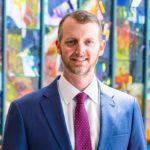By Dr. Jonas Fontenot, PH.D., Chief Operations Officer, Chief of Physics
Innovation comes in many forms and doesn’t always mean creating something brand new. Instead, innovation can take shape as finding a new purpose for an already existing product.
Connel Chu, medical physicist at Mary Bird Perkins Cancer Center, made a pitch to the Cancer Center’s Favre Committee in 2017 for his idea to transform a bi-level positive airway pressure (BiPAP) machine, typically used to treat sleep apnea, to help lung cancer patients breathe in a more controlled way during radiation treatment. Chu’s innovative idea was the first winner of the Favre Family Award for Innovation.
Could A Treatment For Sleep Apnea Help Treat Cancer Patients?
There is a level of difficulty when treating patients with cancer in areas such as the lungs, abdomen or chest. Treating these areas with radiation therapy is like trying to hit a moving target. A person’s breathing pattern is as unique to them as a thumbprint, making it more complex to target cancers in areas that naturally move with each breath.
The Favre Family award grant was used to fund a study on this idea for one year. Chu and LSU Medical Physics graduate student, Cameron Sprowls, studied the breathing movement patterns of cancer patients to determine if the BiPAP machine would assist to control breathing while targeting tumors during radiation therapy.
Many of these patients have difficulty with regular breathing inherently due to the disease. The question behind Chu’s project asks if we can borrow this technology used in sleep medicine to maintain a regular natural breathing motion. Can we use this on patients to improve their ability to breathe regularly to assist with treatment?
Creating a consistent movement that can be predicted during treatment would allow radiation oncologists to target tumors more precisely while minimizing the impact to healthy tissues in the body. The better we’re able to control and predict the breathing motion, the more effective the treatment plan will be.
Mary Bird Perkins Cancer Center Leads Transformation In Cancer Care
The annual Favre Family Award for Innovation, spearheaded in 2016 by a generous donation from philanthropist Art Favre, encourages Mary Bird Perkins team members to cultivate their creativity and submit their ideas for ground-breaking solutions to benefit patients served throughout the Gulf South region. Each grant proposal competes for a $15,000 award to bring the idea to fruition.
After Chu’s study, the project team submitted a manuscript that was recently accepted into the peer-reviewed medical journal Advances in Radiation Oncology. This is great news for the Cancer Center, validating the project as reasonable and significant by physicians from around the country through an independent review.
It’s exciting to have the work justified, and this is an important step in the process. It allows ideas to be tested and challenged by peers in the field and at other organizations.
For Chu, the next step is determining just how much healthy tissue can be spared from unnecessary radiation delivery with assistance of the BiPAP. This project is an important part of radiation oncology’s broader effort for precision medicine and putting the patient at the center of technological advances. We’re searching for a better understanding of the characteristics of each individual patient to provide a larger impact.
The Favre Family Award for Innovation helps increase the standard of cancer care in local communities and beyond through ideas such as Chu’s BPAP For Radiation Therapy. It benefits cancer care locally by bringing resources and innovative ideas to improve the experience and outcomes locally. Those benefits also have a positive impact when the findings are published nationally and internationally, giving more physicians an option to integrate new practices into their treatment plans.
All Mary Bird Perkins Cancer Center team members are eligible and encouraged to submit their innovative ideas by visiting the intranet.

